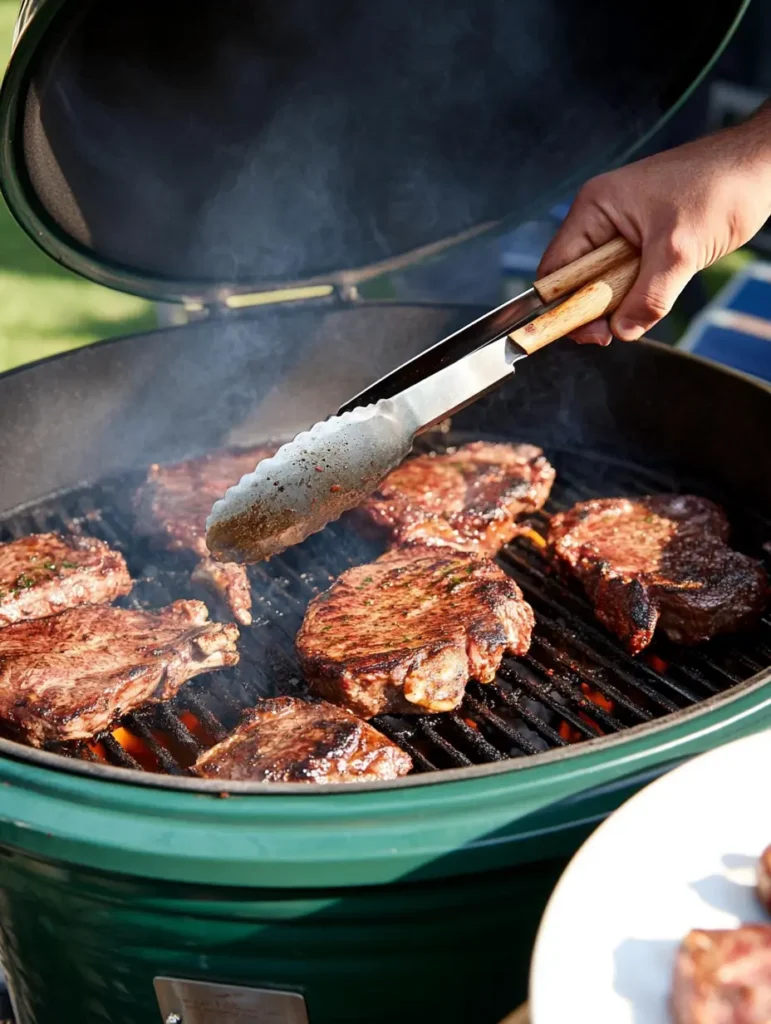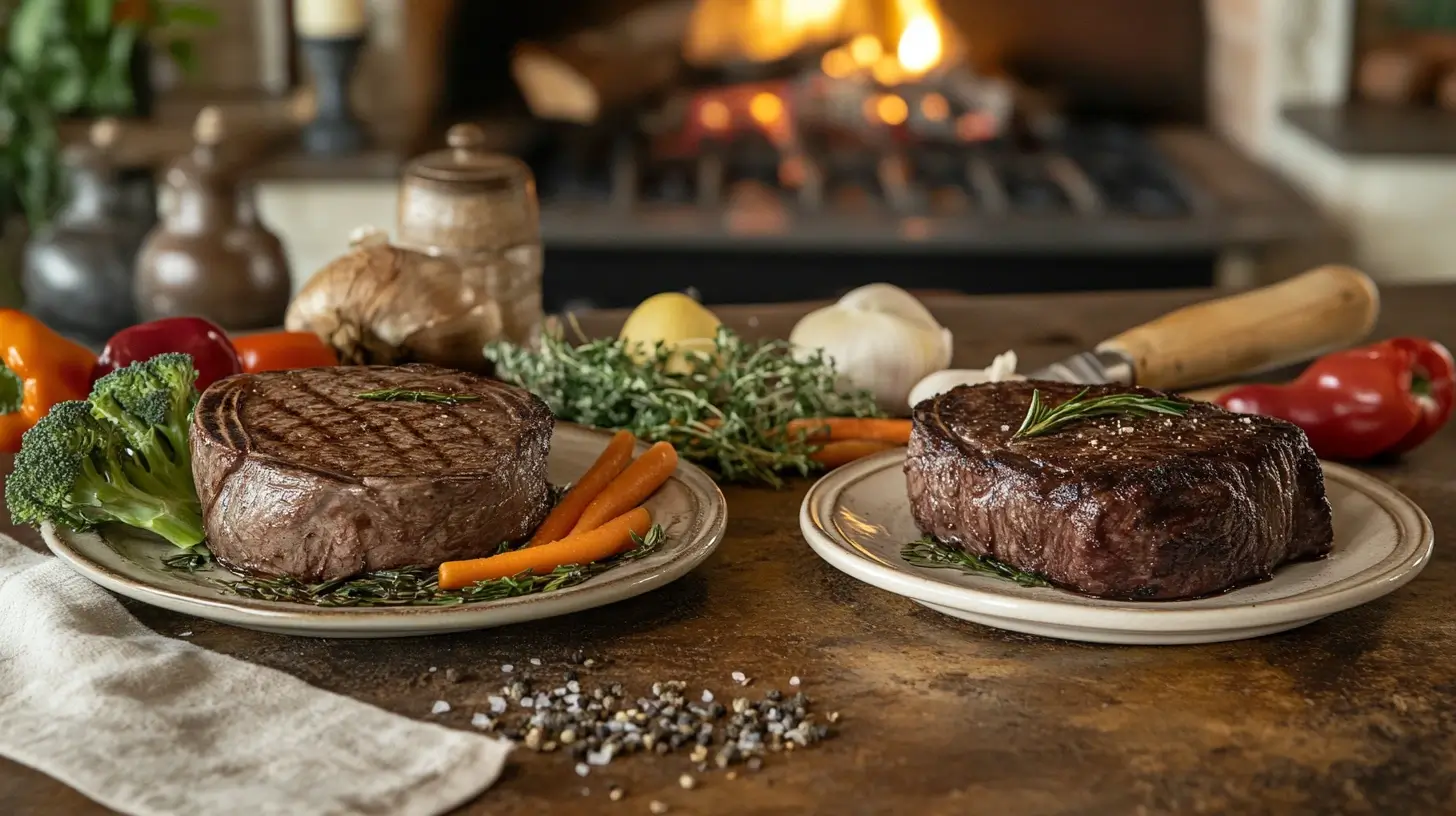When it comes to choosing the right meat for your diet, many people find themselves comparing venison and beef. Both are popular options with unique flavor profiles and nutritional benefits. For those exploring venison as a lean and flavorful alternative, dishes like Venison Chili offer a delicious introduction to this versatile protein. But is venison truly better for you than beef? Let’s dive into the details.
Table of contents
Nutritional Profile
Understanding the nutritional makeup of venison and beef is key to determining which is better for you. Both offer essential nutrients, but their compositions differ significantly, particularly in protein, fat, and micronutrient content.
Macronutrient Breakdown
Protein Content
Both venison and beef are excellent sources of protein, making them great choices for muscle development and repair. Venison, however, tends to have a slightly higher protein concentration per ounce compared to most cuts of beef. A 3-ounce serving of venison typically provides about 26 grams of protein, while the same serving of beef offers around 22-24 grams. This makes venison an appealing choice for those seeking a high-protein, low-fat option.
Fat Composition and Quality
One of the most significant differences lies in fat content. Venison is notably leaner, containing only about 3 grams of fat per 3-ounce serving, compared to beef, which can range from 9 to 18 grams depending on the cut. Additionally, venison fat contains less saturated fat, which is linked to lower cholesterol levels and improved heart health.
Calorie Comparison
The lower fat content in venison also translates to fewer calories. A 3-ounce serving of venison has approximately 130 calories, whereas the same portion of beef can range from 180 to 250 calories. For those on a calorie-restricted diet, venison offers a lighter alternative.
Carbohydrate Levels
Neither venison nor beef contains significant carbohydrates, as both are primarily protein-based foods. This makes them ideal for low-carb diets like keto or paleo.
Micronutrient Content
Vitamins: B12, B6, and More
Both meats are rich in B vitamins, particularly B12, which is essential for energy production and red blood cell formation. Venison offers a slight edge in B6, which supports brain health and immune function.
Minerals: Iron, Zinc, and Selenium
Venison is an excellent source of heme iron, a form of iron that is highly bioavailable. It can help combat anemia and improve oxygen transport in the body. While beef also contains iron, venison’s higher concentration per serving gives it an advantage. Similarly, venison provides a good dose of zinc and selenium, both critical for immune function and cellular repair.
Omega-3 and Omega-6 Fatty Acids
Grass-fed beef and wild venison both contain omega-3 fatty acids, but venison tends to have a more favorable omega-6 to omega-3 ratio. This balance is associated with reduced inflammation and improved heart health, offering venison a slight upper hand for those looking to optimize their omega intake.
Health Benefits of Venison
Venison is often praised for its nutritional advantages, particularly when compared to beef. Its lean nature and nutrient-dense profile make it a standout choice for individuals seeking a healthier alternative to traditional red meat.
Low Fat and Lean Meat Benefits
One of the primary health benefits of venison is its low fat content. With just 3 grams of fat per 3-ounce serving, venison is one of the leanest red meats available. This makes it an excellent option for those monitoring their fat intake, especially saturated fats, which can contribute to high cholesterol levels and cardiovascular issues.
Leaner meat also tends to have a higher protein-to-fat ratio, which helps promote satiety while supporting muscle repair and growth. Additionally, consuming less fat can reduce the risk of obesity-related health issues.
High Protein for Muscle Health
Venison is a protein powerhouse, providing around 26 grams of high-quality protein per serving. This makes it ideal for athletes, fitness enthusiasts, or anyone looking to maintain or build muscle. The protein in venison contains all nine essential amino acids, ensuring that your body gets the nutrients it cannot produce on its own.
Rich in Essential Nutrients
Venison is packed with vitamins and minerals that are essential for overall health. Its high levels of iron help combat fatigue and support proper oxygen transport in the blood. Meanwhile, the presence of zinc bolsters the immune system and aids in wound healing. Venison also provides selenium, which has antioxidant properties that can protect cells from damage and support thyroid health.
The B vitamins in venison, especially B12 and B6, contribute to energy metabolism, red blood cell production, and brain function. For those who may struggle to get enough of these nutrients in their diet, venison can be a highly beneficial addition.
Lower Cholesterol Potential
Venison’s low saturated fat content translates to a reduced impact on blood cholesterol levels. Studies suggest that diets lower in saturated fats can lead to improved heart health by maintaining healthier levels of LDL (bad cholesterol) and HDL (good cholesterol). Choosing venison over fattier cuts of beef may help those at risk of heart disease manage their cholesterol more effectively.

Health Benefits of Beef
While venison offers impressive nutritional benefits, beef remains a staple in many diets for good reason. It provides a wealth of nutrients and serves as a versatile protein source that supports various aspects of health.
High Protein for Energy and Growth
Beef is a rich source of high-quality protein, essential for maintaining energy levels, repairing tissues, and supporting overall growth. With an average of 22-24 grams of protein per 3-ounce serving, beef delivers all the essential amino acids your body needs, making it an excellent choice for active individuals, growing children, and those recovering from illness or injury.
Nutrient-Dense Cuts of Beef
Different cuts of beef offer varying nutritional profiles, with leaner cuts like sirloin and tenderloin being particularly nutrient-dense. These cuts provide significant amounts of iron, zinc, and B vitamins while containing less fat than fattier cuts like ribeye or brisket. Opting for grass-fed beef can further enhance the nutrient profile, as it typically contains higher levels of omega-3 fatty acids and antioxidants.
Source of CLA (Conjugated Linoleic Acid)
Beef, especially from grass-fed cattle, is one of the best dietary sources of conjugated linoleic acid (CLA). CLA is a naturally occurring fatty acid associated with several health benefits, including reduced body fat, improved muscle mass, and potential protective effects against certain types of cancer.
Role in Iron Deficiency Prevention
Beef is a particularly valuable source of heme iron, which is highly absorbable by the body. This makes it an important dietary component for preventing and treating iron deficiency anemia, especially for individuals with higher iron needs, such as pregnant women, growing adolescents, and athletes.
Environmental Impact
Beyond nutritional and health considerations, the environmental impacts of venison and beef are critical factors to examine. The way these meats are sourced and produced can significantly affect sustainability and ecological balance.
Sustainability of Venison
Impact of Deer Hunting and Management Practices
Venison often comes from wild deer, which means its production does not rely on traditional farming practices. This reduces the need for resources like water, land, and feed that are necessary for raising livestock. Hunting and culling deer populations can also help manage overpopulation, which, if left unchecked, may lead to ecological issues such as habitat destruction and reduced biodiversity.
In areas where deer are a significant agricultural or environmental concern, consuming venison is both a sustainable and ethical choice. Since wild deer are not typically raised in concentrated animal feeding operations (CAFOs), their meat has a smaller carbon footprint compared to industrially farmed beef.
Sustainability of Beef
Cattle Farming and Environmental Concerns
Beef production is often associated with significant environmental challenges. Cattle farming requires vast amounts of land, water, and feed, contributing to deforestation, water scarcity, and soil degradation. Moreover, cows produce methane, a potent greenhouse gas that plays a major role in climate change.
While grass-fed beef is generally more sustainable than grain-fed beef, it still requires substantial resources. Practices like rotational grazing and regenerative farming aim to mitigate some of these impacts, but large-scale beef production remains a strain on the environment compared to venison sourced from wild populations.
Ethical Considerations
When comparing venison and beef, ethical concerns surrounding animal welfare, sourcing, and environmental stewardship play a significant role.
Ethical Aspects of Eating Venison
Venison is often regarded as an ethical choice for those who value sustainable and humane meat consumption. Since venison typically comes from wild deer, the animals live in their natural habitat until they are harvested. This eliminates the ethical concerns associated with factory farming, such as confined spaces, overbreeding, and inhumane practices.
Hunting practices that follow ethical guidelines ensure that deer are harvested quickly and humanely. Additionally, hunting can serve a conservation purpose by preventing overpopulation, which can lead to ecological imbalances and food shortages for wild animals. By choosing venison, consumers may support responsible wildlife management efforts and reduce the demand for industrial meat production.
Ethical Aspects of Eating Beef
The ethics of beef consumption are more complex, particularly in industrial farming systems. Many beef cattle are raised in confined animal feeding operations (CAFOs), where they may experience overcrowding, limited access to the outdoors, and stressful living conditions. These practices raise concerns about animal welfare and have sparked movements toward grass-fed and free-range beef options.
On the other hand, small-scale, sustainable cattle farming offers more ethical alternatives, where farmers prioritize humane treatment and environmental sustainability. However, the higher costs of these practices often limit their accessibility for the average consumer.
Ultimately, the ethicality of eating beef depends on its source, with grass-fed, pasture-raised options being preferable to industrially farmed beef.
Culinary Differences
When deciding between venison and beef, the culinary experience is another important factor to consider. Both meats offer distinct flavors and textures, as well as unique opportunities for preparation and enjoyment.
Taste and Flavor Profiles
Venison has a rich, gamey flavor that is more robust than the milder taste of beef. This distinctive flavor is influenced by the deer’s diet, which often consists of wild plants and herbs. For those accustomed to beef, venison’s flavor can seem bold or earthy, making it a favorite among adventurous eaters and gourmet chefs.
Beef, on the other hand, is versatile and widely appreciated for its relatively neutral and savory taste. Depending on the cut and preparation method, beef can range from tender and juicy to hearty and firm, making it a popular choice for a variety of cuisines.
Versatility in Cooking
Both venison and beef are versatile, but their differing fat content affects how they cook. Venison’s lean nature means it can dry out quickly if overcooked, requiring careful preparation to retain moisture and tenderness. Marinating venison or cooking it slowly over low heat can help preserve its texture and enhance its flavor.
Beef, with its higher fat content, is more forgiving during cooking. Cuts like ribeye and brisket are well-suited for grilling, roasting, or slow-cooking, as the fat melts and adds richness to the meat. This versatility makes beef a convenient option for both beginners and experienced cooks.
Common Cooking Techniques
Popular Venison Recipes
- Venison Stew: Slow-cooked with root vegetables and herbs for a hearty meal.
- Venison Sausages: Blended with spices and fats for a flavorful protein option.
- Grilled Venison Steaks: Marinated and cooked medium-rare to highlight the meat’s natural flavor.
Popular Beef Recipes
- Classic Beef Burgers: A staple for quick meals and barbecues.
- Beef Stroganoff: A creamy, comforting dish with strips of tender beef.
- Beef Pot Roast: Slow-cooked with vegetables for a tender and flavorful dish.
Cost and Availability
The cost and availability of venison and beef are important factors that can influence your choice between these two meats. While beef is more commonly found in stores, venison has its own appeal for those who prioritize quality and sustainability.
Price Differences
Venison is often considered a premium meat and tends to be more expensive than beef. This is largely due to its sourcing methods; most venison is wild or farmed on a smaller scale, which increases production costs. Depending on the region, venison may cost $10–$30 per pound, compared to beef, which typically ranges from $5–$20 per pound, depending on the cut and whether it is grass-fed or grain-fed.
Beef’s lower cost and mass availability make it a more budget-friendly option for families and individuals seeking protein on a regular basis. However, premium beef cuts, like Wagyu or grass-fed steaks, can be just as expensive—or even more costly—than venison.
Seasonal Availability
Venison is often a seasonal meat, with its availability peaking during hunting seasons in the fall and winter. While some specialty stores and online retailers offer venison year-round, it may be frozen rather than fresh. For hunters, venison is more accessible, as it can be sourced directly during deer season and stored for future use.
Beef, by contrast, is available year-round in almost every grocery store and butcher shop. Its consistent supply and wide distribution make it a more convenient option for everyday meals.
Accessibility in Markets
Beef is one of the most widely consumed meats in the world and is easily accessible in supermarkets, restaurants, and fast-food chains. Venison, however, is less common and may only be available at specialty stores, farmer’s markets, or through direct purchasing from hunters or small farms. This limited accessibility can make venison less practical for those who don’t have access to specialty retailers.
Comparison Table: Venison vs. Beef
To summarize the differences between venison and beef, here’s a quick comparison of key metrics:
| Category | Venison | Beef |
|---|---|---|
| Protein (3 oz) | ~26 grams | ~22–24 grams |
| Fat (3 oz) | ~3 grams | ~9–18 grams (varies by cut) |
| Calories (3 oz) | ~130 calories | ~180–250 calories (varies by cut) |
| Iron Content | Higher (excellent for anemia prevention) | Moderate (varies by cut and quality) |
| Omega-3 Levels | Good (wild venison especially) | Higher in grass-fed beef |
| Sustainability | More sustainable (wild-sourced or managed) | Less sustainable (industrial farming) |
| Flavor Profile | Rich, gamey, earthy | Mild, versatile, savory |
| Availability | Seasonal; specialty markets | Year-round; widely available |
| Cost | Higher ($10–$30 per pound) | Lower for standard cuts; higher for premium cuts ($5–$20 per pound) |
This table highlights the key nutritional and practical considerations, offering a clear view of how the two meats compare.
Which is Healthier for You?
Choosing between venison and beef ultimately depends on your health goals, dietary needs, and personal preferences. Both meats offer unique benefits and cater to different priorities.
Ideal Choice for Specific Health Goals
- Weight Management:
Venison’s low calorie and low fat content make it an excellent choice for those trying to lose or maintain weight. Its high protein concentration also promotes satiety, which can help curb overeating. - Muscle Building:
While both venison and beef are rich in protein, venison provides a slightly higher protein content per serving, making it a great option for athletes or anyone looking to build muscle. - Heart Health:
Venison’s lower saturated fat content and favorable omega-6 to omega-3 ratio give it the edge for those focused on cardiovascular health. Lean cuts of grass-fed beef can also be heart-healthy but may contain more fat overall compared to venison. - Anemia Prevention:
If boosting iron levels is a priority, venison takes the lead with its higher heme iron content, which is more bioavailable than the iron in beef. This makes it ideal for individuals prone to iron deficiency.
Dietary Restrictions and Preferences
- Low-Fat Diets:
Venison is a better option for low-fat diets due to its naturally lean composition. - Keto or Paleo Diets:
Both meats are suitable, but venison may appeal more to those seeking wild or natural protein sources that align with the paleo lifestyle. - Accessibility Needs:
For those who require consistent access to affordable protein, beef is the more practical choice, given its year-round availability and lower cost for standard cuts.
Conclusion on Health Benefits
While venison has several nutritional advantages, including being leaner and richer in certain nutrients, beef remains a dependable option with a broader range of cuts to fit different health needs. Ultimately, the healthiest choice depends on factors like your dietary goals, cooking preferences, and ethical considerations.
FAQs
Is venison healthier than grass-fed beef?
Both are excellent choices, but venison is generally leaner with fewer calories. Grass-fed beef, however, contains higher levels of omega-3 fatty acids and CLA.
Does venison have more iron than beef?
Yes, venison typically contains higher levels of heme iron, making it particularly beneficial for individuals with iron deficiency.
Is venison suitable for people with heart disease?
Yes, venison’s low saturated fat content and favorable fatty acid profile make it a heart-healthy choice when prepared without added fats.
Conclusion
- Recap of Main Points:
Venison and beef both offer unique benefits. Venison stands out for its leanness, higher protein content, and sustainability, while beef shines with its versatility, accessibility, and nutrient density. - Recommendations:
For individuals seeking a lean, nutrient-packed option and supporting sustainable practices, venison is a fantastic choice. Those who prefer a more accessible, budget-friendly protein may find beef a better fit. Balancing both in your diet allows for variety and nutritional benefits tailored to your lifestyle and goals.

